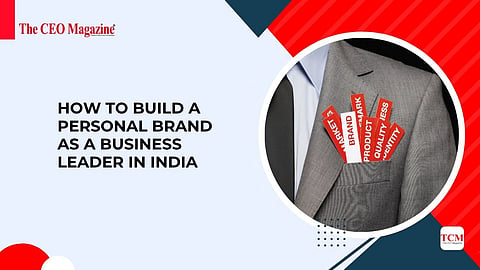
- News
- Women
- Magazine
- IndustryIndustry
- InsightsInsights
- Success Stories
- PublishPublish
- ContactContact
- Media KitMedia Kit

Build a Personal Brand
In today’s hyper-connected world, your personal brand is more powerful than your company logo.
Let me ask you this:
If your name appeared in someone’s search bar right now, what would they find?
Would they discover a trusted thought leader… or a digital ghost?
As a CEO, founder, or entrepreneur, building a personal brand isn’t optional anymore — especially in India, where trust, visibility, and leadership presence can accelerate your business and your influence.
“Your brand is what people say about you when you're not in the room.”
– Jeff Bezos
Let me walk you through how I (and countless Indian business leaders I’ve worked with) have built personal brands that attract opportunities, investors, talent, and impact — all without becoming a ‘social media influencer’.
Whether you’re raising capital, hiring top talent, or entering a new market, your personal brand speaks for you — often before you do.
Here’s why you must invest in building it:
People buy from people, not companies.
Founders with strong personal brands raise 2–3x faster (source: Forbes India).
Your voice online helps shape industry influence and media credibility.
It becomes a magnet for strategic partnerships.
In India, trust plays a big role in business decisions. Your personal brand builds that trust at scale.
Before you jump on LinkedIn or start writing blogs, let’s get clear.
What do I stand for beyond my company?
What am I known for (or want to be known for)?
What kind of impact do I want to create in my industry or society?
The Visionary Founder (e.g. Nithin Kamath of Zerodha)
The Industry Educator (e.g. Kunal Shah of CRED)
The Cultural Voice (e.g. Falguni Nayar of Nykaa)
The Impact Leader (e.g. Ritesh Agarwal of OYO)
Pick a lane that feels natural and aligned with your purpose.
In the digital-first business world, Google is your first handshake.
Here’s how to ensure you make a powerful first impression:
Use a clear professional photo.
Write a headline that shows what you do + who you help.
Your “About” section should tell your story, values, and vision — not just your resume.
Create a personal website (even a one-pager).
Claim your Google Knowledge Panel (if eligible).
Write articles on high-authority platforms like www.theceo.in, Startupcity india, or LinkedIn Articles.
Here’s the secret: Even two well-optimized guest posts can help dominate page one of search results for your name.
In India, we connect through stories, not stats.
“We raised ₹50 Cr in Series A.”
“When we bootstrapped for 2 years, there were months we couldn’t pay ourselves. Here's what kept us going.”
People relate to pain, perseverance, and passion — that’s what builds emotional resonance.
Lessons from mistakes or pivots
Stories behind milestones
Views on industry trends or policy changes
Thoughts on leadership, hiring, or innovation
Personal values or philosophies
“The more personal your story, the more universal it becomes.”
– Brené Brown
Don’t try to be everywhere. Be strategic.
LinkedIn – Thought leadership, hiring, B2B credibility.
X (formerly Twitter) – Policy opinions, VC conversations, fast news.
Instagram or YouTube – Behind-the-scenes, personal life, or visual storytelling.
Medium/Substack – Long-form, intellectual pieces.
Post at least 2x/week on LinkedIn.
Comment on 5-10 industry posts daily to stay visible.
Use tools like Buffer or Notion to plan your content.
In my experience, just 90 days of consistent content can drastically change how you’re perceived in the business world.
You don’t need to “go viral”. You need to be credible.
Speak at industry panels or webinars.
Collaborate with journalists (get quoted in business features).
Get featured in interviews on platforms like The CEO Magazine India and Startup City India Magazine.
Pitch your story to startup podcasts or news platforms.
Join or create a mastermind group of fellow Indian founders — cross-tagging each other amplifies everyone.
Every time you share your voice in public, you shape your brand narrative.
Your personal and business brands should complement each other, not compete.
What you believe → Your leadership messaging
What your company does → Your thought leadership focus
What your audience wants → Your content value
Example:
If your startup is solving India’s financial inclusion gap, your content should touch on:
Indian financial literacy
Rural fintech opportunities
Inclusive innovation
This ensures that every post grows both your personal influence and your company’s authority.
Yes, even your personal brand needs KPIs.
Profile visits and impressions (LinkedIn analytics)
Follower quality (Are they industry relevant?)
DM inquiries or collaboration invites
Mentions in media or podcasts
Speaking invites or investor intros
Use tools like Shield App (for LinkedIn) or Google Alerts for tracking.
Remember: What gets measured gets improved.
Honest takes on the Indian economy, behavioral psychology, and startups.
Over 1M followers across platforms.
Shares stories about health, entrepreneurship, and sustainable business.
Transparent about bootstrapping and long-term thinking.
Speaks to India’s young professionals with relatable life lessons.
Converted his personal brand into books, courses, and community.
Let me leave you with this:
You are already known for something. The question is — are you in control of that narrative?
In today’s competitive business landscape, your personal brand is your reputation, your resume, and your ROI.
Start small. Start now.
Tell your story before someone else does.
Follow us on Google News
